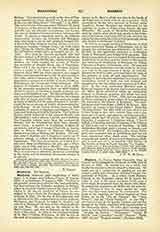

Marchi, GIUSEPPE, archaeologist, b. at Tolmezzo near Udine, February 22, 1795; d. at Rome, February 10, 1860. He entered the Society of Jesus at Rome November 12, 1814, shortly after the reestablishment of the order and was professor of humanities successively in the colleges of Terni, Reggio-Emilia, Modena, and St. Andrew of the Quirinal. After completing his course and making his religious profession (1833) he became professor of rhetoric in the Roman College and held this position until 1842. Meanwhile, he devoted his leisure to study, applying himself through choice to profane antiquities. In 1838 he was made prefect of the Kircher Museum which office he retained until his death. He soon gave special attention to Christian antiquities, hoping thus to find a means of restoring Christian art. In 1840 he announced his intention of collecting into one large publication the monuments of Christian architecture, painting, and sculpture. His archaeological pursuits recommended him to Gregory XVI as qualified to succeed Settele in the position of “Conservatore dei sacri cimiteri di Roma” (1842). About this time Marchi made the acquaintance of youthful Giovanni Battista De Rossi, who accepted him as master and thenceforth accompanied him on his visits to the catacombs. These ancient cemeteries had been deplorably abandoned but thereafter were more accessible and could be studied on the ground. In 18March 44i published the first volume of his “Monumenti”, devoted to the construction of the catacombs, especially that of St. Agnes. He proved the Christian origin of these ancient burial-places and, through his studies, was brought about (March 21, 1845) the discovery of the crypts of Saints Peter and Hyacinth in the catacomb of St. Hermes. To De Rossi, however, was reserved the honor of the great discoveries in the Roman catacombs. He knew better than Marchi how to make use of ancient topographical data and all the resources of learning. Marchi was appointed Consultor of the Congregation of the Index in 1847 and several years later (1854) he took part in the creation of the Lateran Museum of which, with de Fabris, he became director. In July, 1855, his labors were interrupted for the first time by a stroke of apoplexy, to which he succumbed in 1860. The notes intended for the continuation of the “Monumenti” were lost, but some of them were found by Father Bonavenia and made known at the Second Congress of Christian Archaeology at Rome (1900). These recovered documents were destined for the second volume of the “Monumenti”, which was to treat of the non-cemeterial Christian architecture of Rome. The full titles of his works are: “Musei Kircherniani Inscriptiones ethnicae et christianae” (Milan, 1837); “L’aes grave del Museo Kircheriano, ovvero le monete primitive dei popoli dell’ Italia media,” in collaboration with P. Tessieni (Rome, 1839); “Monumenti delle arti cristiane primitive nella metropoli del cristianesimo: I. Archittetura “della Roma sotteranea cristiana” (Rome, 1844).
R. MAERE

